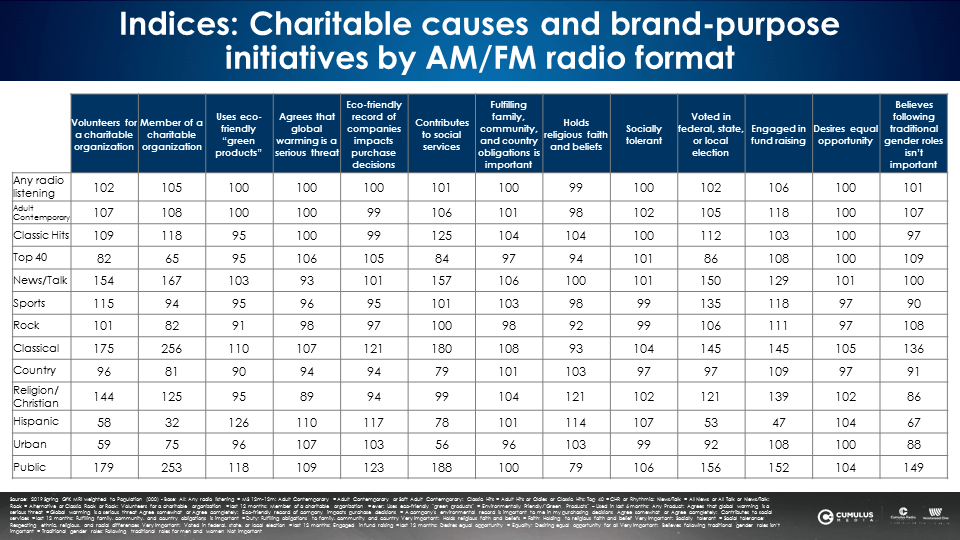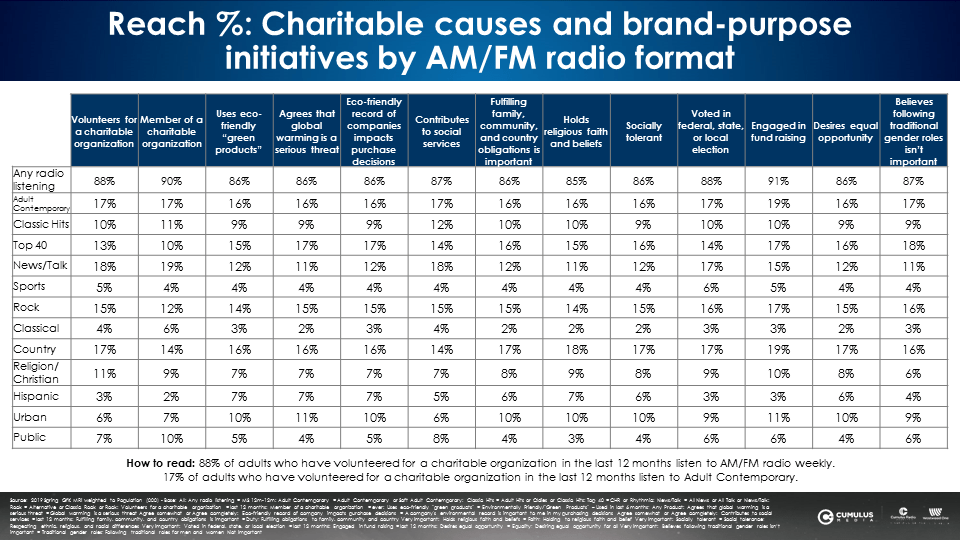Find Causes That Resonate With AM/FM Radio Audiences: AM/FM Radio Format Planning Tool
For many advertisers today, selling a product or service isn’t enough. Companies also have brand-purpose initiatives aimed at bettering the world.
Brand purposes can range from environmental issues, equality, local charities, or community concerns. Major names in the industry cite their brand purpose as important corporate cornerstones that guide their overall strategy. In addition to working towards improvements, brand purpose is used as a way to connect with consumers.
Procter & Gamble, for example, believe in putting the power of their brands behind issues that benefit society to grow business. Marc Pritchard, the company’s Chief Brand Officer, has spoken extensively about how “new expectations from consumers around brands doing good work required a new approach.”
As such, P&G has “specific measurable commitments and goals that must be met.” P&G’s strategy is to use advertising “as a force for good and a force for growth.”
When consumers share a belief in a brand’s purpose, they feel connected. According to Pritchard, “Nine out of 10 people say they have a more positive image of a company when it supports social or environmental causes, and half say they make purchase decisions based on shared beliefs with the brand.”
Consumers want brands that support important social issues
A recent national study conducted by research firm NuVoodoo found that Americans want brands that support current social issues like the Black Lives Matter movement. Most consumers had positive impressions of companies or media outlets that issued statements, publicly donated, ran ads, explicitly denounced White Supremacy, and removed or changed offensive content that had previously aired.
| Q: “What impression do you have of a company or media outlet that does the following?” | % who answered “positive” |
| Issues a statement that supports Black Lives Matter | 61% |
| Runs ads that support Black Lives Matter |
61% |
| Publicly donates to Black Lives Matter or other affiliated organization | 60% |
| Explicitly acknowledges and denounces White Supremacy |
54% |
| Removes or changes offensive content that has aired previously | 53% |
|
Source: NuVoodoo National Study, 6/19/2020 – 6/26/2020, total sample = 5231, P16-54 |
|
So where can brands find these consumers who are committed to the same issues? AM/FM radio.
Below are two AM/FM radio brand-purpose planning grids. These tools can be used to find rich concentrations of listeners who personally align with specific causes.
Indices: Charitable causes and brand-purpose initiatives by AM/FM radio format
The first planning tool depicts brand-purpose indices for each AM/FM radio programming format.

How to read: Find a cause across the top and read the column below it to see how each AM/FM radio programming format indexes against that cause. Notable brand-purpose indices examples include:
- Charitable organizations: News/Talk listeners are 54% more likely to have volunteered for a charitable organization in the last 12 months and are 67% more likely than the general population to be a member of a charitable organization
- Eco-friendly: Spanish radio listeners care about the environment, being 26% more likely to use eco-friendly “green products” and 17% more likely than the general population to have their purchase decisions impacted by the eco-friendly record of companies
- Politically involved: Sports listeners are 35% more likely than the general population to have voted in a federal, state, or local election in the last 12 months
Reach %: Charitable causes and brand-purpose initiatives by AM/FM radio format
The second planning grid depicts the audience reach of brand-purpose targets achieved with AM/FM radio programming formats.

How to read: Find a cause at the top and read the column below it to see what % of the purpose target can be reached on the AM/FM radio programming format audience. For example:
- Financial contributor: 87% of those who have contributed to social services in the last 12 months listen to AM/FM radio weekly
- Religious: 18% of those who hold religious faiths and beliefs are reached by Country AM/FM radio on a weekly basis
- Equal opportunity: 16% of those who desire equal opportunity are reached by Top 40 AM/FM radio weekly
Best practice: Prioritize reach, the #1 media sales driver, over index
While indices are important indicators of consumer beliefs, brands often chase big indices that generate very little reach. With such tight targeting, sales and profits tend to be lower.
According to a Nielsen study of nearly 500 advertising campaigns, reach is by far the most significant media driver of sales. For brand-purpose campaigns to make a meaningful impact, select AM/FM radio formats with large amounts reach among target audiences.
Pierre Bouvard is Chief Insights Officer at CUMULUS MEDIA | Westwood One.
Contact the Insights team at CorpMarketing@westwoodone.com.